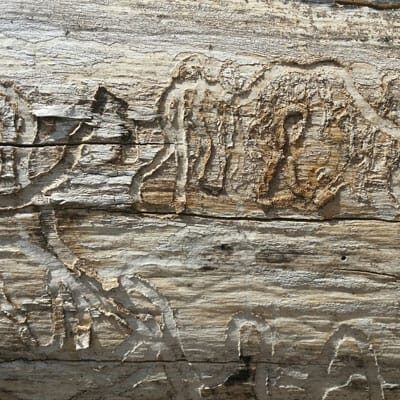Emerald Ash Borer Treatment
About Emerald Ash Borer
Emerald Ash Borer (EAB), Agrilus planipennis Fairmaire, is an exotic beetle that arrived in Ohio in 2003 and has now spread to all 88 counties in the state. Ash trees infested with EAB generally die within 3 to 5 years if not treated early - without treatment there's a 99% mortality rate.
The adult beetles nibble on ash foliage but cause little damage. It's the larvae (the immature stage) that are the real culprit - they feed on the inner bark of ash trees, disrupting the tree's ability to transport water and nutrients, slowly "starving" the tree until it dies.
With 3.8 million ash trees in Ohio alone (one in 10 of our trees is an ash), the Emerald Ash Borer is devastating our landscapes and forests. All five of Ohio's native ash species are susceptible to EAB, with only a few individual trees showing any degree of resistance to the pest.
>> Watch our video on how to identify and treat EAB in Ohio
At this point you have two options - treat your ash trees for EAB or cut them down before they become a safety hazard.
Treatment Procedure
For the EAB treatment that we use, the arborist drills small holes in the base of your ash tree and then plugs the holes with the Arborjet system. The arborist then injects an insecticide called TREE-äge® until the tree has completely absorbed the appropriate amount.
Treatment Effectiveness
In several intensive studies conducted by MSU and OSU researchers, a single injection of TREE-äge® provided excellent control of Emerald Ash Borer for approximately two years, even under high pest presence. This means that you typically only need to treat your trees for EAB every two years.
Treatment Impact
Because the EAB treatment is injected directly into the tree, there's no chemical spray to worry about. The tree absorbs the insecticide and spreads it throughout the trunk, branches and leaves where the beetles and larvae will ingest it and die. There's no exposure to you, your pets or the environment.
Below you can see the difference between an ash tree that's been treated by Arbor Experts since 2008 (left) and one that hasn't (right). Between 2015 and 2017 there was a significant decline in the health of the ash on the right as it was slowly killed by Emerald Ash Borers.



When to treat Emerald Ash Borer
Ash trees may be treated spring through fall and should be treated as soon as possible to prevent damage.
An affected ash may still be treatable as long as less than 1/3 of the tree is damaged. However, treatment is not a magic bullet - visible recovery can take several years and treatment is not guaranteed to always save your tree. An ash tree may have additional damage beyond that caused by the EAB that makes it a poor candidate for treatment, even if less than 50% of the tree is affected.
This may sometimes be difficult to assess, however, because it is not possible to see all internal damage that has been done. That's why it's important to have a Certified Arborist examine your ash tree(s) before making any decisions about treatment or removal.
It's also why we recommend EAB treatment before your tree shows signs of infestation or damage. When an ash tree is infested, it can take years before damage becomes obvious when viewed from the ground, even though extensive damage is being done internally.
Give us a call at 937-233-4118 to set up a consultation. Our arborists will be able to tell you whether or not it's advisable to treat your ash tree, and can evaluate whether or not deadwood pruning should also be done to remove safety hazards if your tree is already showing signs of Emerald Ash Borer damage.


